In my application, I want to bind GridControl to DataTable that contains data from multiple database tables (referenced with foreign keys).
I had a problem with updating data, since I was using SqlDataAdapter on a command that referenced multiple database tables. I was getting error:
Dynamic sql generation is not supported against multiple base tables
I tried to work it around by creating a view that was combining multiple tables into one "table" that I could then bind to my GridControl.
Inserting data was done using "instead of" trigger on the view in which I was adding appropriate data to appropriate tables. In plain t-sql, inserts work flawlessly. I can insert data into my view and it is being inserted into appropriate table. My SqlDataAdapter should have no problems updating since it's updating one "table" and the rest of updates is being done by triggers.
Unfortunately, I am still getting error
Dynamic sql generation is not supported against multiple base tables
Do you have any idea why SqlDataAdapter is still not letting me update, even thought it's now updating only one "table" - view?
My code:
The view:
CREATE view [dbo].[v_TestTypeParameter_grid]
as
(
select t1.Id, t3.Name, t3.Description, t2.MinValue, t2.MaxValue, t4.Symbol
from TestTypes as t1 join
TestTypeParameters as t2 on t1.Id = t2.TestType join
Parameters as t3 on t2.Parameter = t3.Id left join
Units as t4 on t2.Unit = t4.Id
)
Instead of trigger on view:
CREATE TRIGGER [dbo].[tr_TestTypeParameterAdded] ON [dbo] [v_TestTypeParameter_grid]
INSTEAD OF INSERT
AS
BEGIN
DECLARE
@TestTypeId int,
@ParameterId int,
@UnitId int,
@ParameterName varchar(100),
@MinValue decimal(18,2),
@MaxValue decimal(18,2),
@UnitSymbol varchar(100)
SELECT @TestTypeId = Id, @ParameterName = Name, @MinValue = MinValue, @MaxValue = MaxValue, @UnitSymbol = Symbol FROM Inserted;
SELECT @ParameterId = Id FROM Parameters WHERE Name = @ParameterName;
SELECT @UnitId = Id from Units WHERESymbol = @UnitSymbol;
INSERT INTO TestTypeParameters(TestType, Parameter, MinValue, MaxValue, Unit) VALUES(@TestTypeId, @ParameterId, @MinValue, @MaxValue, @UnitId);
END
My binding code:
mvarParameterListAdapter = DBService.GetDataAdapter("select * from v_TestTypeParameter_grid where Id = " + mvarTestTypeId);
mvarParameterTable = new DataTable();
mvarParameterListAdapter.Fill(mvarParameterTable);
gcParameters.DataSource = mvarParameterTable;
gcParameters.RefreshDataSource();
DBService.GetDataAdapter method:
public static SqlDataAdapter GetDataAdapter(String command, DataTable parameters = null)
{
SqlConnection lvarConnection = GetConnection();
SqlCommand lvarCommand = new SqlCommand(command, lvarConnection);
if (parameters != null && parameters.Rows.Count > 0)
{
foreach (DataRow lvarRow in parameters.Rows)
{
lvarCommand.Parameters.AddWithValue("@" + lvarRow[0], lvarRow[1]);
}
}
SqlDataAdapter lvarAdapter = new SqlDataAdapter(lvarCommand);
SqlCommandBuilder lvarCommandBuilder = new SqlCommandBuilder(lvarAdapter);
return lvarAdapter;
}
Update code:
try
{
mvarParameterListAdapter.Update(mvarParameterTable);
}
catch (Exception ex)
{
// Here, I'm getting the error
}
Insert that works in t-sql:
INSERT INTO v_TestTypeParameter_grid VALUES (2, 'Fe', 'Iron', 5.2, 7.9, '%')
Since I have several GridControls that work like this (with different data), I am trying to not generate select, insert, update and delete commands for SqlDataAdapter myself, instead of that, I'm using SqlCommandBuilder to keep it simpler.
Thanks!
EDIT:
To (hopefully) make things clear:
This is the GridControl I am working on. Forgive me for the column names, they're in Polish. Identyfikator = Id, Nazwa = Name, Opis = Description, Minimum = MinValue, Maksimum = MaxValue, Jednostka = Unit
For now, I am adding another row to GridControl that only contains the "Nazwa (Name)" and "Opis (Description)" fields.
I am filling "Identyfikator(Id)" field with the Id of the TestType that I want to add parameters to and other fields with their default values. The new row is automatically being added to the DataTable that is bound to my GridControl and after user clicks "Save", I want to push those changes to the database using SqlDataAdapter.Update() method. This is where I am getting error:
Dynamic sql generation is not supported against multiple base tables
I hope it made it clear what I want to achieve and how I'm trying to do it.
EDIT:
I managed to find a solution to this problem. You can check it in my answer below.
